Monte Vista Christian Church History
Monte Vista is the oldest congregation in Nob Hill with buildings that are examples of Southwestern architecture, as well as a Kiva Chapel, and our unique Wicks/Ahlborn pipe-digital hybrid organ. The light in the chapel showcases stained glass windows by well-known local artist, Arthur Sussman.
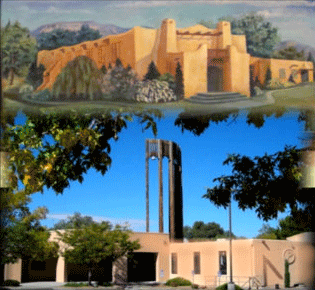
OVER NINETY YEARS OF
FAITH, LOVE AND SERVICE
Called as partners in Christ's service,
Called to ministries of grace,
We respond with deep commitment
Fresh new lines of faith to trace.
-Jane Parker Huber
The ancient Hebrews, very aware of their need to tell and preserve their story, drilled that story into the consciousness of generation upon generation. We cannot tell our full story here; we can only hint at 90 years of faith, love and service, and we must start with the beginning.
THE EARLY YEARS
When love is strained and dissension comes, faith must close the breach. Separation was not the intention when a group from an existing church organized a Bible School in April 1931. The 101 participants met in a rented building in downtown Albuquerque (pop. 28,000). Weekly prayer meetings in addition to the Sunday classes helped the group to grow in faith and love. It soon became apparent that they were in effect a separate body.
Founding a new congregation requires a great leap of faith, and faith was a precious commodity in 1931 when the nation and world were shuddering from economic turmoil. Central Christian Church was born in that act of faith, boldly committing itself to all the service a full-grown congregation should provide locally and beyond.
The minutes of the newly elected board in November 1931 indicate the treasury held $314.68 (multiply by 12 for approximate current equivalent), and there was a motion to pay to have the door repaired to keep out the wind. More important than the door is the mention of a Missionary Committee, indicating that service was already important to the life of Central Christian Church. Strong youth groups were also contributing to outreach. Service is further reflected in the first annual report showing 548 pastoral visits during the year and $199.06 paid to missions, plus additional amounts to the Denver Orphanage (now Colorado Christian Home) and Sandia Conference (ancestor of the Tres Rios summer programs).
Faith was not limited to members of the congregation who soon realized they needed a permanent home. A lumber company granted extended credit to the struggling group trying to build on an oddly shaped lot that realtors were glad to sell for a reduced fee because it seemed useless for any other purpose. It was a combination of faith, love and service that guided the women to prepare those now-famous 35 cent lunches (creamed chicken, hot biscuits, slaw, lemon pie) to help finance the building project, and the men who donated their labor to create on a sandy mesa what was to become Monte Vista Christian Church. When the sanctuary was dedicated in 1935, a congregation of 340 could boast having raised $15,000 and having assigned 13% of the church's income for outreach. From this growing body three young people had indicated a desire to prepare for a church vocation. Monte Vista Christian Church, in only a few years, had already charted a course of faith, love and service.
This new church served the neighborhood. The next nearest church was a mile away, and children from various denominations soon helped fill the cramped Monte Vista Sunday School rooms. By 1940 scouting programs for boys and girls helped the congregation serve another segment of Nob Hill's new population. This increased activity required an expanded facility, and in 1940 the congregation took another step of faith to build the first Bethany Hall.
How firm a foundation, ye saints of the Lord,
Is laid for your faith in his excellent word.
-Early American Hymn
The oft-told story of Monte Vista's first decade bears reviewing not merely for nostalgia, but also because it reminds us how firmly the founders laid a foundation upon which the church we know today would grow. A lesser foundation would not have sustained nor survived another sixty years.
The decade set the pattern for the mission of the congregation in its faith-based love and service in Albuquerque, the state, nation and the world. The years that followed varied little in theme; only the temporal circumstances and needs differed. Names of clergy, agencies and organizations changed, but the Monte Vista spirit did not.
WORLD WAR II
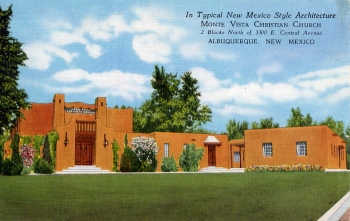
The decade of the '40s was dominated by World War II and its aftereffects, completely remaking sleepy Albuquerque (pop. 34,000). Monte Vista could not avoid the dramatic and traumatic events of the times that tested the faith of every Christian. Ninety-one young men and women responded to the nation's military call. Ten young men never returned.
The women of the congregation extended their love and service through hours of Red Cross work. Civil defense measures designated the church building as an emergency Red Cross hospital, although it was never needed for that purpose. The USO, YMCA, Veterans' Hospital and the air base felt the Monte Vista spirit of service. The needs of the local population continued despite the war, and the women's organizations in the congregation, in addition to supporting the building fund, reached out to the needy as well as to foreign missions. The minister wrote letters to all members in the armed services; there were union Thanksgiving services and work with the University Inter-Faith Council. When First Congregational Church, also new to the mesa, was without a minister, Monte Vista invited that congregation to come worship until a new minister arrived. Despite the restrictions imposed by the war, the summer camp and conference programs continued.
The congregation continued to grow with the city as new people who had never experienced New Mexico came with the military and remained or returned in retirement. The average Sunday School attendance in 1942 was 235. The city's fluid population created a kind of revolving-door Monte Vista. Extraordinary numbers of weekly additions were countered as other people moved away leaving a fairly constant number of members. Faith and love in action matched the population growth, and the building of Steen Hall in 1949 provided more space for education. Giving to missions increased to 31.5% of the church budget, and the congregation gave generously to the denominational Crusade for a Christian World.
POSTWAR
The end of the war brought new challenges to the congregation through the changing needs of society. Monte Vista supported the War Relief Fund, aid to lepers and Japanese war widows. There were cooperative Vacation Church Schools for the neighborhood. During 1947-48 the minister made weekly radio addresses to reach the city. Monte Vista called its first Director of Religious Education and also chose to support a Living-Link Missionary. Easter 1949 had 528 in Sunday School and 1,244 in the three worship services. The time had come to call an assistant pastor in 1950.
We would be building, Master, let Thy plan
Reveal the life that God would give to man.
-Purd Deitz
With its firm foundation, unshaken by the greatly different traumas of two decades, Monte Vista bravely and confidently began to shape itself for the years ahead and build-not simply for itself, but also for a city of 95,000.
THE 50s
With the confidence of founding a congregation still alive in the memory of the church, Monte Vista again stretched out in faith, love and service to establish the Sombra del Monte congregation with financial and membership support to boost the new venture. That did not mean that the parent could rest and look inward. This was a vital time for loving service to extend in many different areas, including military bases. There was a seasonal drive-in church, and a local radio station broadcast the Sunday morning services from our own sanctuary. Support for missions continued. We did not forget our members in the military in another war or those away in school. Quiet support went out as financial aid to seminary students and scholarships for children needing help to attend summer camp. The first phase of Williamson Hall rose across the street from the original 1935 building. The restless urge to grow did not diminish, and by 1959 plans began to form another new congregation, the one that would become Los Altos Christian Church. Albuquerque could then boast three Disciples congregations.
THE 60s
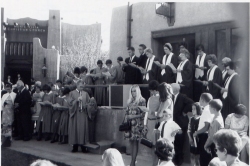
One might assume from reading this cursory account that the Monte Vista journey experienced no delays and that faith was never challenged. It would be dishonest to suggest this was true. There were always financial strains resulting from the ambitious determination of the congregation to fulfill its vision and to respond to the needs of the city, as well as those of the denomination's state, national and international aspirations. Sometimes great acts of faith brought faltering results. The 1960 cooperative project for the Rancho del Monte camp and conference site near Santa Fe failed to realize its promise. Valle Vista, Monte Vista's first attempt to establish a new church on the West Mesa, did not survive. We learned from our mistakes; guided by outstanding clergy, we grew in faith and love; we continued to serve, and we continued to build.
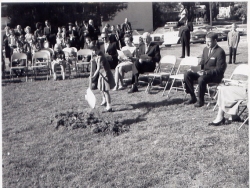
Extensive remodeling and expansion of the sanctuary and physical plant greatly altered the Monte Vista profile and generated a further sense of purpose and service. The upper story of Steen Hall became Keystone Chapel, named in honor of the Keystone Class that provided for the remodeling. Monte Vista retired its old electronic organ in favor of a new Wicks instrument designed specifically for the sanctuary. Church membership passed the 1,000 mark in the mid '60s as the congregation moved in many directions to demonstrate faith and love in action for needy people, refugee families and a pre-school for special needs children. Not forgetting our own, we began the shepherding program. Entering what was to become a lasting tradition, we joined a union Thanksgiving service that included a Jewish congregation.
THE 70s
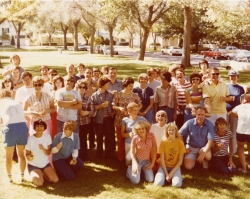
The Black River Conference Center (now Black River Center for Learning and formerly Tres Rios Area Growth Center) absorbed a great deal of mental, physical and spiritual energy during the '70s. Those same years saw a substantial revision in the working procedures of the congregation as it drew upon forty years of experience in learning how to operate efficiently without sacrificing the firm foundation of faith, love and service.
Those internal matters did not deter the demonstrations of love that expects no return as the congregation began its long and regular association with the blood bank and a counseling center, in addition to the many services it provided through long-standing affiliation with numerous local agencies as well as the national and international needs.
OUTREACH IN THE 80s
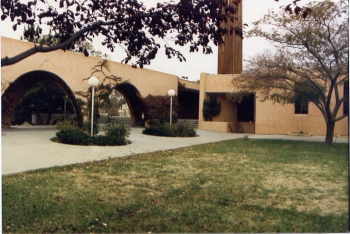
Reaching ever farther outward in love and service in the '80s could have resulted in neglect of individual attention. That did not happen to Monte Vistans who helped finance two heart transplants, one locally, another in California. An outstanding local accomplishment during the '80s was anothercampaign for growth that brought into being the third new congregation, this time for the West Mesa, born in a Roman Catholic church one windy afternoon. There were other kinds of building, too. During those years the congregation began a regular and sustained relationship with Habitat for Humanity by supplying $50,000 seed money to establish Habitat in Albuquerque. Volunteer labor followed the funding.
BETHANY HALL AND HABITAT
This association led the congregation into a moment of great pride for the '90s when we financed and helped build our first Habitat house. This was a real financial challenge for a group still struggling with payments on the new Bethany Hall complex. The faith that we would succeed was strong, and backed by the love and service of many volunteers, that faith became reality.
Earlier programs for seniors had faded. Their revitalization brought the lively Monte Vista Roadrunners. The Seniors' Academy, reaching the entire region, established itself as an annual event. All-church retreats helped increase the sense of intergenerational community. The Parish Nursing Ministry was an immediate success in bringing wellness and assistance to all ages. Youth mission trips spread the Monte Vista spirit of love and service into other states. Striving for new ways to reconnect ourselves with and serve the neighborhood, we continued the successful Halloween Carnival and Trunk-or-Treat event for children.
Be Thou my vision, O Lord of my heart;
Naught be all else to me, save that Thou art-
-Ancient Irish, versed by Eleanor Hull
VISION
The closing year of the century found this congregation free of debt without sacrificing the many areas of worship, service, education and music. Looking ahead in faith, the congregation accepted a visionary plan for the future. Monte Vista will seek and find new faith to meet the contingencies the coming years will offer as challenge to our spirit.
TRANSLATIONS
In January 1988, The Reverend Jack Oliver, an interim minister, preached on the subject "The Bible's Best Translation." The gist of that sermon defined the best as that which translates words into a spiritual life. How does one measure or describe the spiritual life of a congregation? Is it by the number of people who participated in Kerygma or ABIL study courses? Is it by those conscientious members who wrote to service personnel, sent cards and flowers to the sick or grieving and prepared meals for them, or is it by those who volunteered to teach, supervise, catalog books, make music to the glory of God? Does the clergy transform the congregation into a new translation?
There was an earlier reference to a whimsical item in board minutes about repairing a door to keep out the wind. Would anyone care to estimate the dollar value of the services donated by the Fix 'n' Fixit men? Who can count the children and adults who were able to sleep warmly under new blankets or face the world with a renewed sense of pride because of new clothing from Sew 'n' Sew? What unseen lives have been touched as Women's Ministry (formerly known as CWF) continues to incorporate outreach as part of its budget? How do we repay the members who volunteer for Meals on Wheels, Dismas House, day-care centers and hospitals? We have only to look about us to see and be grateful for those silent translations of love that have come back to us through memorial gifts realized in many projects. Can we measure the worth of our Timothys and Phoebes? All these, and dozens of others not mentioned here, are translations of the Bible we need to study, review and emulate.
For seventy years, the musicians of all ages at Monte Vista have helped teach and practice our faith through their own forms of love-based service, alone or in combination with musicians from other congregations, in music for worship, inspiration and sometimes entertainment. Life at Monte Vista without their translation of the Bible would be unthinkable.
Monte Vista Christian Church is now living what will become its history, and we, like those ancient Hebrews, must have a story to preserve, a story based on faith, love and service to tell the twenty-first century, proudly demonstrating that with seventy years of experience we are the best translation of the Bible that we can possibly aspire to be.
MINISTERS THROUGH THE YEARS
| 1931-1938 |
Rev. and Mrs. Guy B. Williamson |
| 1939-1946 |
Rev. N.R. Simpson |
| 1946-1952 |
Rev. Ira Bailes |
| 1948-1949 |
Ella Mae Allen, Dir. of Religious Education |
| 1951 |
Rev. Robert Lohman, Asst. Min. |
| 1952-1958 |
Rev. Roy Ford |
| 1955-1958 |
Rev. Glenn Ricketts, Asst. Min. |
| 1958-1966 |
Rev. Truce Lewellyn |
| 1959-1961 |
Rev. John Bray, Asst. Minister |
| 1962-1964 |
Dr. Jerry Thompson, Min. of Education |
| 1966-1976 |
Dr. Theo Fisher |
| 1966-1971 |
Rev. Patricia Clark Barbier, Min. of Education |
| 1972-1990 |
Dr. Art Vermillion, Assoc. Min. |
| 1976-1987 |
Rev. William Sturgess |
| 1988-1994 |
Dr. William Dorman |
| 1990-1995 |
Rev. Phillip Hoyle, Assoc. Min. |
| 1994-1995 |
Erik Rolstad, Dir. of Youth |
| 1994-1996 |
Rev. Herbert Simpson, Min. of Pastoral Care |
| 1994-2003 |
Rev. Leslie Denton, Min. of Education |
| 1995-1996 |
Monica Hawes, Dir. of Youth |
| 1995-2004 |
Rev. Fred Dorisse |
| 1996-1997 |
Stacy Sturgess, Dir. of Youth |
| 1996-1999 |
Rev. Glenn Ricketts, Min. of Membership |
| 1998-2001 |
Karla Bell, Dir. of Youth |
| 1999-2007 |
Dr. Michelle Tatlock, Min. of Membership |
| 2001-2017 |
Robert Aubrey, Associate Minister |
| 2005-2016 |
Rev. Laurie Lewis, Senior Minister
|
| 2016-2017 |
Rev. Brenda Warren, Interim |
| 2017-2025 |
Rev. Dr. Dawn Rosignol, Senior Minister |
| 2018-2021 |
Br. Ryan Roberts, Associate Minister
|
| 2021-2023 |
Rev. Meredyth Jones, Associate Minister
|
TIMOTHYS & PHOEBES
(Known Living)
Alan Abraham
Linda McKiernan Allen
Walter Allen
Audrey Anderson
Dick Cayton
Sally Bone Clarkson
Eleanor Kelly Cooley
John Dyer
Wallace Ford
Richard Hough
Joan Quick
John Quick
David Rogers
Martha Nell Bowman Simpson
Amanda Tatlock
In appreciation to Ray Reeder for authoring this history.

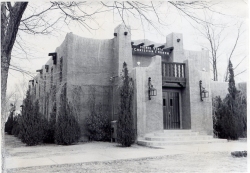
 The decade of the '40s was dominated by World War II and its aftereffects, completely remaking sleepy Albuquerque (pop. 34,000). Monte Vista could not avoid the dramatic and traumatic events of the times that tested the faith of every Christian. Ninety-one young men and women responded to the nation's military call. Ten young men never returned.
The decade of the '40s was dominated by World War II and its aftereffects, completely remaking sleepy Albuquerque (pop. 34,000). Monte Vista could not avoid the dramatic and traumatic events of the times that tested the faith of every Christian. Ninety-one young men and women responded to the nation's military call. Ten young men never returned. One might assume from reading this cursory account that the Monte Vista journey experienced no delays and that faith was never challenged. It would be dishonest to suggest this was true. There were always financial strains resulting from the ambitious determination of the congregation to fulfill its vision and to respond to the needs of the city, as well as those of the denomination's state, national and international aspirations. Sometimes great acts of faith brought faltering results. The 1960 cooperative project for the Rancho del Monte camp and conference site near Santa Fe failed to realize its promise. Valle Vista, Monte Vista's first attempt to establish a new church on the West Mesa, did not survive. We learned from our mistakes; guided by outstanding clergy, we grew in faith and love; we continued to serve, and we continued to build.
One might assume from reading this cursory account that the Monte Vista journey experienced no delays and that faith was never challenged. It would be dishonest to suggest this was true. There were always financial strains resulting from the ambitious determination of the congregation to fulfill its vision and to respond to the needs of the city, as well as those of the denomination's state, national and international aspirations. Sometimes great acts of faith brought faltering results. The 1960 cooperative project for the Rancho del Monte camp and conference site near Santa Fe failed to realize its promise. Valle Vista, Monte Vista's first attempt to establish a new church on the West Mesa, did not survive. We learned from our mistakes; guided by outstanding clergy, we grew in faith and love; we continued to serve, and we continued to build. Extensive remodeling and expansion of the sanctuary and physical plant greatly altered the Monte Vista profile and generated a further sense of purpose and service. The upper story of Steen Hall became Keystone Chapel, named in honor of the Keystone Class that provided for the remodeling. Monte Vista retired its old electronic organ in favor of a new Wicks instrument designed specifically for the sanctuary. Church membership passed the 1,000 mark in the mid '60s as the congregation moved in many directions to demonstrate faith and love in action for needy people, refugee families and a pre-school for special needs children. Not forgetting our own, we began the shepherding program. Entering what was to become a lasting tradition, we joined a union Thanksgiving service that included a Jewish congregation.
Extensive remodeling and expansion of the sanctuary and physical plant greatly altered the Monte Vista profile and generated a further sense of purpose and service. The upper story of Steen Hall became Keystone Chapel, named in honor of the Keystone Class that provided for the remodeling. Monte Vista retired its old electronic organ in favor of a new Wicks instrument designed specifically for the sanctuary. Church membership passed the 1,000 mark in the mid '60s as the congregation moved in many directions to demonstrate faith and love in action for needy people, refugee families and a pre-school for special needs children. Not forgetting our own, we began the shepherding program. Entering what was to become a lasting tradition, we joined a union Thanksgiving service that included a Jewish congregation. The Black River Conference Center (now Black River Center for Learning and formerly Tres Rios Area Growth Center) absorbed a great deal of mental, physical and spiritual energy during the '70s. Those same years saw a substantial revision in the working procedures of the congregation as it drew upon forty years of experience in learning how to operate efficiently without sacrificing the firm foundation of faith, love and service.
The Black River Conference Center (now Black River Center for Learning and formerly Tres Rios Area Growth Center) absorbed a great deal of mental, physical and spiritual energy during the '70s. Those same years saw a substantial revision in the working procedures of the congregation as it drew upon forty years of experience in learning how to operate efficiently without sacrificing the firm foundation of faith, love and service. Reaching ever farther outward in love and service in the '80s could have resulted in neglect of individual attention. That did not happen to Monte Vistans who helped finance two heart transplants, one locally, another in California. An outstanding local accomplishment during the '80s was anothercampaign for growth that brought into being the third new congregation, this time for the West Mesa, born in a Roman Catholic church one windy afternoon. There were other kinds of building, too. During those years the congregation began a regular and sustained relationship with Habitat for Humanity by supplying $50,000 seed money to establish Habitat in Albuquerque. Volunteer labor followed the funding.
Reaching ever farther outward in love and service in the '80s could have resulted in neglect of individual attention. That did not happen to Monte Vistans who helped finance two heart transplants, one locally, another in California. An outstanding local accomplishment during the '80s was anothercampaign for growth that brought into being the third new congregation, this time for the West Mesa, born in a Roman Catholic church one windy afternoon. There were other kinds of building, too. During those years the congregation began a regular and sustained relationship with Habitat for Humanity by supplying $50,000 seed money to establish Habitat in Albuquerque. Volunteer labor followed the funding.